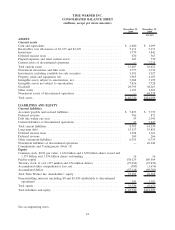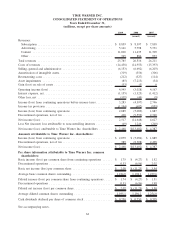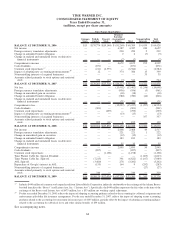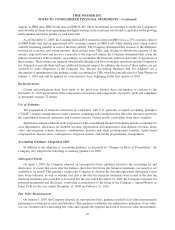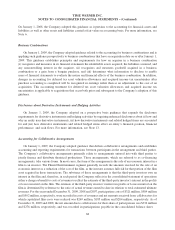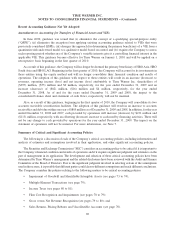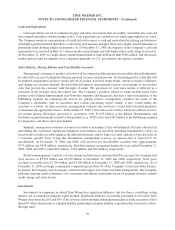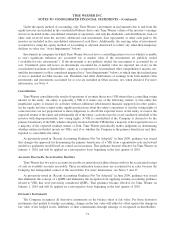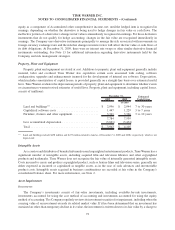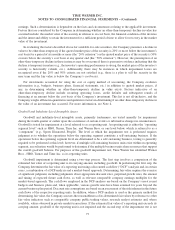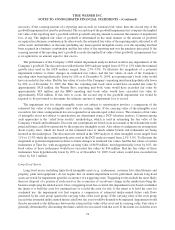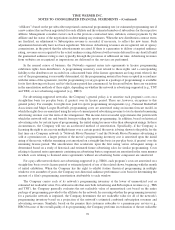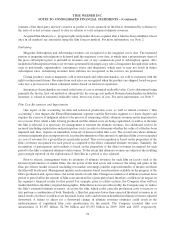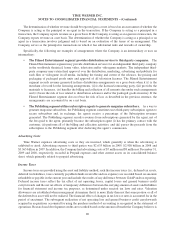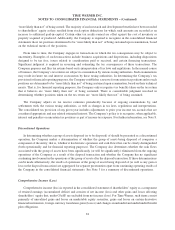Time Magazine 2009 Annual Report Download - page 83
Download and view the complete annual report
Please find page 83 of the 2009 Time Magazine annual report below. You can navigate through the pages in the report by either clicking on the pages listed below, or by using the keyword search tool below to find specific information within the annual report.Under the equity method of accounting, only Time Warner’s investment in and amounts due to and from the
equity investee are included in the consolidated balance sheet; only Time Warner’s share of the investee’s earnings
(losses) is included in the consolidated statement of operations; and only the dividends, cash distributions, loans or
other cash received from the investee, additional cash investments, loan repayments or other cash paid to the
investee are included in the consolidated statement of cash flows. Additionally, the carrying value of investments
accounted for using the equity method of accounting is adjusted downward to reflect any other-than-temporary
declines in value (see “Asset Impairments” below).
Investments in companies in which Time Warner does not have a controlling interest or over which it is unable
to exert significant influence are accounted for at market value if the investments are publicly traded
(“available-for-sale investments”). If the investment is not publicly traded, the investment is accounted for at
cost. Unrealized gains and losses on investments accounted for at market value are reported, net-of-tax, in the
consolidated statement of shareholders’ equity as a component of Accumulated other comprehensive income, net,
until the investment is sold or considered impaired (see “Asset Impairments” below), at which time the realized gain
or loss is included in Other income, net. Dividends and other distributions of earnings from both market-value
investments and investments accounted for at cost are included in Other income, net, when declared. For more
information, see Note 4.
Consolidation
Time Warner consolidates the results of operations of an entity that is not a VIE when it has a controlling voting
interest in the entity. An entity is generally a VIE if it meets any of the following criteria: (i) the entity has
insufficient equity to finance its activities without additional subordinated financial support from other parties,
(ii) the equity investors cannot make significant decisions about the entity’s operations or (iii) the voting rights of
some investors are not proportional to their obligations to absorb the expected losses of the entity or receive the
expected returns of the entity and substantially all of the entity’s activities involve or are conducted on behalf of the
investor with disproportionately few voting rights. A VIE is consolidated if the Company is deemed to be the
primary beneficiary of the VIE, which is the party involved with the VIE that has a majority of the expected losses or
a majority of the expected residual returns or both. Time Warner periodically makes judgments in determining
whether entities in which it invests are VIEs, and, if so, whether the Company is the primary beneficiary and, thus,
required to consolidate the entity.
As previously noted in “Recent Accounting Guidance Not Yet Adopted,” in June 2009, guidance was issued
that changes the approach for determining the primary beneficiary of a VIE from a quantitative risk and reward
model to a qualitative model based on control and economics. That guidance became effective for Time Warner on
January 1, 2010 and will be applied on a retrospective basis beginning in the first quarter of 2010.
Accounts Receivable Securitization Facilities
Time Warner has two active accounts receivable securitization facilities that provide for the accelerated receipt
of cash on available accounts receivable. These securitization transactions are accounted for as sales, because the
Company has relinquished control of the receivables. For more information, see Notes 7 and 17.
As previously noted in “Recent Accounting Guidance Not Yet Adopted,” in June 2009, guidance was issued
that eliminates the concept of a QSPE and eliminates the exception from applying existing accounting guidance
related to VIEs that were previously considered QSPEs. That guidance became effective for Time Warner on
January 1, 2010 and will be applied on a retrospective basis beginning in the first quarter of 2010.
Derivative Instruments
The Company recognizes all derivative instruments on the balance sheet at fair value. For those derivative
instruments that qualify for hedge accounting, changes in the fair value will either be offset against the change in
fair value of the hedged assets, liabilities or firm commitments through earnings or recognized in shareholders’
71
TIME WARNER INC.
NOTES TO CONSOLIDATED FINANCIAL STATEMENTS – (Continued)


